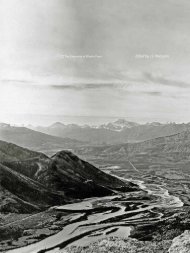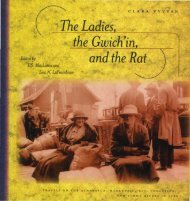Paul Kane's Journal of his Western Travels, 1846-1848 - History and ...
Paul Kane's Journal of his Western Travels, 1846-1848 - History and ...
Paul Kane's Journal of his Western Travels, 1846-1848 - History and ...
You also want an ePaper? Increase the reach of your titles
YUMPU automatically turns print PDFs into web optimized ePapers that Google loves.
Winnipeg, to which it is connected by a narrows, or the<br />
recommencement, after passing through the north end <strong>of</strong> Lake<br />
Winnipeg, <strong>of</strong> the Saskatchewan River, its waters continuing on<br />
to Hudson Bay.<br />
point de boan/Point de boan In the Wood River valley, Pointe<br />
des Bois, flooded today by one <strong>of</strong> the Columbia River's thirteen<br />
dams, was a point <strong>of</strong> l<strong>and</strong> around which the ttail across Athabasca<br />
Pass had to negotiate. It was both densely wooded <strong>and</strong><br />
boggy. In such a narrow valley, the ttail must have seemed at<br />
times to be the riverbed itself, at times dense, flooded woods -<br />
both bitter tonnents, especially in cold weather, for man <strong>and</strong><br />
horse alike.<br />
point de Tramble See Lake Winapeg.<br />
point min. See Lake Winapeg.<br />
Point <strong>of</strong> Woods Pointe des Bois, or Pointe aux Chenes, was the<br />
name given to the fall <strong>and</strong> portage ten miles downriver from<br />
Chute a Jacques (see rapid de gock) on the Winnipeg River.<br />
Alternatively, it lay one mile above Rocher Briile portage.<br />
)lOuder See Muck-e-too.<br />
Pourtage new In <strong>his</strong> list <strong>of</strong> portages on the Columbia River, Kane<br />
mentions a name not commonly used. His list appears to follow<br />
the course <strong>of</strong> the Columbia, the last entry being the lowest<br />
feature on the river. The Cascades, however, were always<br />
described as the last downriver, or, for those venturing inl<strong>and</strong>,<br />
the "first" (WA [180]) upriver obstructions; yet, the name <strong>of</strong> the<br />
Cascades precedes that <strong>of</strong> Pourtage new in t<strong>his</strong> list.<br />
Powder See Muck-e-too.<br />
prarie de fay Thirty-six miles up the Columbia River from Fort<br />
Vancouver <strong>and</strong> fourteen miles downriver from the Cascades,<br />
Prairie de The must have been somewhere between modem<br />
Multnomah Falls, Oregon, <strong>and</strong> Skamania, Washington. Its<br />
whereabouts have not been confirmed, but it is known that the<br />
name was widely used in accounts <strong>of</strong> the lower Columbia.<br />
Prew T<strong>his</strong> is another voyageur who is known entirely by <strong>his</strong><br />
(probably) misspelled surname. See also Lefrombeys.<br />
Prudence, Mr. Chief Factor John Peter Pruden (bapt. 1778; d.<br />
1868), the man for whose baptismal place Fort Edmonton was<br />
named, was the great uncle <strong>of</strong> the bride, Margaret Harriott<br />
Row<strong>and</strong>, the daughter <strong>of</strong> John Harriott (see Haritt/Harett/<br />
H., Mr.) <strong>and</strong> <strong>his</strong> first wife, Elizabeth, who disappeared in<br />
Athabasca Pass, <strong>and</strong> who was herself John Peter Pruden's<br />
daughter. (Could the bride, then, possibly have been the newborn<br />
baby who had to be saved in Athabasca Pass <strong>and</strong> taken to<br />
Fort Edmonton? She would have been age seventeen that<br />
December <strong>of</strong> 1847.)<br />
Pruden had become a councillor <strong>of</strong> Assiniboia in 1839,<br />
retiring to Red River eventually, although he had obviously<br />
come to Fort Edmonton (perhaps for the wedding) in De·<br />
cember, 1847. In <strong>his</strong> "Character Book," Governor Simpson<br />
thought little <strong>of</strong> him: "A man <strong>of</strong> good conduct <strong>and</strong> character<br />
<strong>and</strong> <strong>of</strong> respectable appearance <strong>and</strong> manner but weak minded<br />
vain & silly without decision in or knowledge <strong>of</strong> business<br />
beyond the simple process <strong>of</strong> dealing with an Indian across the<br />
Counter" (188).<br />
Punch Bowl<br />
82<br />
See Cometees punch boal.<br />
R. River See Red River.<br />
rabbet point See Lake Winapeg.<br />
Raney Lake/ Lack Ie Plue Rainy Lake is located in rough<br />
woodl<strong>and</strong>s along the modem Ontario/Minnesota border, 150<br />
miles west <strong>of</strong> Lake Superior. By way <strong>of</strong> Rainy River, its waters<br />
flow west to Lake <strong>of</strong> the Woods.<br />
rapid de god/Chute a Jocka Chute a Jacques, a fall <strong>of</strong> fifteen<br />
feet on the Winnipeg River, ninety miles downstream from Lake<br />
<strong>of</strong> the Woods, was seen by Kane on June 9, <strong>1846</strong>, <strong>and</strong> August<br />
11, <strong>1848</strong>. WA explains that the fall takes its name from a<br />
voyageur who attempted an unprecedented shooting <strong>of</strong> it <strong>and</strong><br />
died (44). The modem name is Lamprey Falls.<br />
rapped de More Named "Rapids de Mort" in WA (101),<br />
today's Gooseneck Rapids lie forty miles below the town <strong>of</strong><br />
Hinton, Alberta, on the Athabasca River, they form part <strong>of</strong> a<br />
swift stretch <strong>of</strong> the river, with waves more than three feet high,<br />
which extends from the mouth <strong>of</strong> Oldman Creek (<strong>Kane's</strong> oald<br />
mans river) to the mouth <strong>of</strong> the Berl<strong>and</strong> River (<strong>Kane's</strong> Bateseis<br />
River <strong>of</strong> November 22, 1847). T<strong>his</strong> is likely the same rapid as<br />
the one Kane called Gr<strong>and</strong> raped when he went by snowshoe<br />
downriver on November 18, 1847.<br />
Rapped de prate Probably <strong>Kane's</strong> spelling <strong>of</strong> Rapid de Pretre,<br />
Priest Rapids is now inundated by a reservoir <strong>of</strong> the same name<br />
in central Washington state. According to Gabriel Franchere,<br />
an Astorian (see Astoria), the rapid on the Columbia River<br />
was "thus named in 1811 ~y [another Astorian] Mr [David]<br />
Stuart <strong>and</strong> <strong>his</strong> party on meeting a number <strong>of</strong> Indians, one <strong>of</strong><br />
whom mimicked religious ceremonies <strong>and</strong> the action <strong>of</strong> sprinkling<br />
with holy water."<br />
rapped <strong>of</strong> deth See daD de more.<br />
Rapped St. Marton/river S~ Martin/Rappe st Maran Presumably,<br />
Kane means St. Martin rapids <strong>and</strong> St. Martin River. At<br />
the rapids the incident concerning cannibalism by the Iroquois<br />
began. Given the order <strong>of</strong> incidents in that narrative, both the<br />
river <strong>and</strong> the rapid, where it joins the Columbia, lie upriver <strong>of</strong><br />
Dalle de Mort, that is, below Boat Encampment <strong>and</strong> above<br />
modem Revelstoke, British Columbia, <strong>and</strong> Upper Arrow Lake.<br />
Rat portage/Rat Portage Rat Portage (est. 1790) was passed<br />
by Kane June 7, <strong>1846</strong>, <strong>and</strong> visited August 14-16, <strong>1848</strong>.<br />
Situated along the portage <strong>of</strong> the same name at the outlet<br />
(north shore) <strong>of</strong> Lake <strong>of</strong> the Woods into the Winnipeg River<br />
(at modem Kenora, Ontario), Rat Portage was built by the<br />
North West Company <strong>and</strong> maintained as a provisioning point<br />
<strong>and</strong> trading post by the HBC following the merger <strong>of</strong> 1821 .<br />
","Red River The name refers to both a river <strong>and</strong> the oldest<br />
settlement in the fur trade empire. At 550 miles, Red River<br />
takes its rise at Lake Traverse, on the Minnesota/North Dakota<br />
border, flowing north into Manitoba <strong>and</strong> Lake Winnipeg. The<br />
river's color comes from the clay in its trench.<br />
Red River Colony began as a settlement for retired voyageurs<br />
<strong>and</strong> their Metis families, <strong>and</strong> was introduced to systematic<br />
farming in 1812, when Lord Selkirk attempted to<br />
"plant" a colony <strong>of</strong> British <strong>and</strong> European immigrants at it.<br />
Of tangential interest are the Red River carts <strong>of</strong> the Metis, to<br />
which Kane refers (see, for example, the entry under June 24,<br />
<strong>1846</strong>) <strong>and</strong> which several <strong>of</strong> <strong>his</strong> paintings depict. These were <strong>of</strong><br />
Guide
















